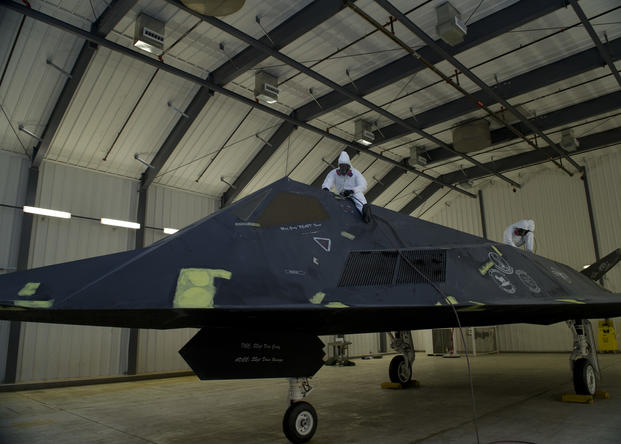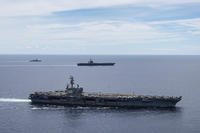The F-117 Nighthawk has been spotted over the Nevada desert occasionally in recent years, raising questions why a "retired" plane has made its way onto a flightline.
Technically categorized as "flyable storage," the remaining single-seat, twin-engine aircraft in the Air Force inventory are tucked away at test and training ranges in Tonopah, Nevada.
But in accordance with the National Defense Authorization Act of 2017, passed Dec. 23, the Air Force will remove four F-117s every year to fully divest them -- a process known as demilitarizing aircraft, a service official told Military.com on Monday.
"Flyable storage" aircraft are not considered classified, said the official, who requested anonymity to free discuss the program. This is why aviation enthusiasts may have spotted the stealth aircraft flying in 2014 and again in 2016 and again as they were taken out for training flights.
Related content:
- Pilot Dies in 'Classified' Plane Crash at Nevada Training Range
- 2 A-10s Crash in Nevada, Pilots Eject, Air Force Says
- Thunderbirds Pilot Told About 'Extreme Precipitation' Before Crash
"We had to keep all the F-117s in flyable storage until the fiscal '17 NDAA gave us permission to dispose of them," the official said. "Once we have it, [Congress] doesn't let us to get rid of anything, but do it in phases, like keep it in backup inventory, primary aircraft assigned, or flyable storage."
Congress gave authority in 2007 and 2008 to retire a total of 52 F-117s from the inventory, but wanted them maintained so they could be recalled into future service in case they were needed for a high-end war, the official said.
F-117 Nighthawk: Going Away Forever?
But in coming years, the stealth attack plane -- capable of attacking high value targets without being detected by enemy radar -- may permanently fade to black.
"We're supposed to dispose of one [Nighthawk] in 2017 and approximately four every year thereafter," the official said.
One is scheduled to be divested this year.
The transition to “demilitarize” and decrease the inventory of the aircraft is defined in the Defense Department’s 41-60.21, “Defense Materiel Disposition Manual.”
Depending on what the aircraft does or what DoD plans to do with it -- such as put it in a museum, for example -- the manual dictates how to dispose by eliminating the functional capabilities of the plane.
“Sometimes the boneyard does that, sometimes they don’t,” the official said, referring to Davis-Monthan Air Force Base, Arizona, where retired planes call home after they’ve been deactivated.
Furthermore, once the aircraft is declared as “excess after deactivation,” sometimes the aircraft can be sold off to other federal agencies in need, if it applies.
The F-117 first saw combat during Operation Just Cause on Dec. 19, 1989, according to the Air Force, but remained under the radar for years.
The F-117 flew as an unacknowledged program for almost nine years before it was considered in active service in the 1980s. The service even crashed a few during trials.
Questions surged over the Nighthawk's role recently after a pilot was killed in a "classified" plane crash last week at the Nevada Test and Training Range.
Lt. Col. Eric Schultz, 44, died from injuries sustained when his aircraft crashed last Tuesday at the range, located about 100 miles northwest of Nellis Air Force Base.
Air Force Chief of Staff Gen. David Goldfein on Saturday quashed speculation that the aircraft involved in the incident was an F-35 Joint Strike Fighter, which would have marked the first crash for the service's newest and most technically advanced aircraft.
"I can definitely say it was not an F-35," he told a Military.com reporter accompanying him on a trip to the National Guard Association of the United States in Louisville, Ky.
The aircraft involved in the crash has not been identified.
-- Oriana Pawlyk can be reached at oriana.pawlyk@military.com. Follow her on Twitter at @Oriana0214.










